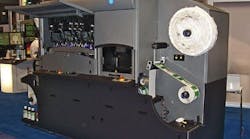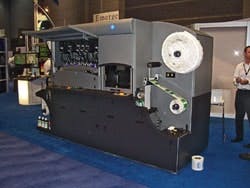Jim Montague is the executive editor for Control, Control Design and Industrial Networking. Email him at [email protected] or check out his Google+ profile.
Many material suppliers claim to be their customers' best partner and pal. However, few if any are so devoted to their users' capabilities and performance that they'll organize an entirely new division to develop solutions for them.
Well, Inx Int'l in Schaumburg, Ill., did exactly that a few years ago to help users of its high-performance inks and coatings make the move from conventional to digital printing, including developing new machines and integration services. The division, Inx Digital, and its Evolve program help users shorten runs and cycle times, and expand operating flexibility by employing digital inkjet printing in many formats, such as wide, super-wide, narrow-web, ultraviolet (UV) flat-bed, pre-press, glass and credit cards.
SEE ALSO: Printing Machine at Powell's in Portland
"New technology is bombarding the graphic arts industry with continual changes, choices and challenges," says Rick Clendenning, Inx Digital's president. "Companies that succeeded by mastering and advancing traditional printing processes need to look to digital integration for new avenues of sales and growth, while those already established in the digital arena need an evolving source for digital inks, printers, software and support."
With graphics roots that go back more than 100 years, Clendenning says the company understands the mindset of traditional printers. So, he adds, "We put trained specialists in place to help, not only with existing needs, but to guide and advise users on digital opportunities, and help them make the transition to digital with a customized seamless integration process. We can customize the perfect ink for virtually any jetting device and substrate, support users with advanced digital printers, and assist them with software, electronics and maintenance."
Colorful Background
Established in 1992, Inx Int'l is part of Sakata Inx, Osaka, Japan, a $1.3-billion company that's been making inks since 1896. Inx Int'l has more than 15 plants in the U.S. and Canada, and more than 50 locations worldwide on four continents.
[pullquote]Inx claims it's now the third-largest ink producer in the U.S., the world's largest producer of inks for metal decorating, the leading producer of water-based, flexographic inks, and the only major ink supplier to also manufacture its own coatings. It adds it's the only North American ink provider that focuses solely on formulations for printing from basic chemistries through finished product, and it also provides advanced, environmentally-conscious ink systems and services for digital printing.
Digital Division
To organize and build Inx Digital, the larger company started with four key acquisitions, which serve as the digital division's initial foundation. In 2005, Inx Int'l bought Triangle Digital of San Leandro, Calif., which supplies digital inks and related services.
It continues to market its Triangle-brand, wide-format inkjet inks, and is even introducing a trio of new digital inks with better flexibility and adhesion.
Next, in 2007, the division acquired custom machine builder and system integrator Innovative Solutions (ISI) of Owens Cross Roads, Ala. "We owned a patent on in-the-round digital printing, but we'd been printing on aluminum bats," says Jim Lambert, who founded ISI and is now vice president and general manager of Inx Digital. "Inx recognized that the bats were similar to the beverage cans its customers were printing on, and so they looked to us to help. We hadn't been directly affiliated with an ink company before, but we knew it was critical to many applications. In fact, Inx serves just about 100% of the U.S. beverage can market because its inks provide the best adhesion and formability. So, we began to focus our core technologies on Inx's traditional business and its customers' transition to digital printing."
Finally, in 2008, Inx acquired Megaink Digital in the Czech Republic and Anteprima SRL of Milan, Italy. Megaink specializes in solvent-based inks for wide and super-wide format digital printers. Anteprima also makes digital printing inks, as well as bulk ink-delivery systems and wide-format printers.
New Machines
Now, it's been a few years since the division was formed, and the cooperative efforts are beginning to bear some fruit in the form of new machines.
For example, Lambert reports that Inx Digital recently designed and launched its CP100 cylinder printer, which consists of a digital printing array that can add images and even textures on all sides of cans, water bottles or other cylindrical objects. In fact, Inx Digital just helped Liberty Bottleworks in Yakima, Wa., produce a distinctive bottle that is colored and has the same slightly dimpled texture as a football. The resulting tactile response is proving to be a hit with young consumers, but the bottles require CP100's jet-curing capability to dry Inx's thicker layer of formable ink fast enough to produce required volumes.
INX Digital's NW140 inkjet, UV, digital, narrow, web press uses 12-print heads and a laser die-cutting system to print, cut and convert labels with adhesive on a paper backing in one step, instead of requiring two or three machines.
In addition, Inx Digital recently partnered with Komori America and Spartanics, both of Rolling Meadows, Ill., and together the three companies developed the NW140 inkjet, UV, digital, narrow, web press, which was beta-tested for two years until earlier this year, and released in September. Spartanics supplies its X140 laser die-cutting system and machine-assembly services, and Komori agreed to distribute the NW140s.
Equipped with a 140-mm print zone and die-cutting field, NW140 is designed to print, cut and convert labels with adhesive on a paper backing in one step, instead of requiring the two or three machines that used to be needed for these types of multiple operations.
NW140 employs 12 digital print heads with six ink channels, as well as a custom-designed, high-efficiency, water-cooled UV LED curing system, and an air-cooled UV LED pinning system. The press also supports media on 3-in. cores up to two feet in diameter, and uses Inx's Evolve Advanced Digital Solutions brand ink. NW140 is controlled by Inx Digital's JetInx print head drive and ink recirculation system, which allows its UV LED curing system to achieve a fast, single-pass output of up to 80 feet per minute on label stock.
Consquently, NW140 takes in project orders from the end user's PDF file, and then Spartanics' job scheduling and web control software instruct the web press and laser-cutting system, and coordinate with JetInx on data required by the print heads. All of NW140's motion functions are performed by Mitsubishi servodrives, amplifiers and PLCs, while other functions are controlled by Rockwell Automation's RSLogix software. Also, each of the 12 print heads has its own microprocessor, and they're managed by Inx Digital's proprietary controls.
"Since the last Labelexpo show a year ago in Chicago, we've made some upgrades to the NW140," Lambert adds. "By using Spartanics' X140 laser die-cutting station, we're able to combine printing and conversion in one machine, which makes it very unique in the marketplace."
Clendenning adds, "Above all, we're committed to bringing our customers consultation and service to help them not only adapt to business conditions, but to exploit those conditions to their utmost advantage. We tell them that we'll put our engineers and systems analysts together with theirs, and we'll collaborate to bring them better ways to print digitally."







